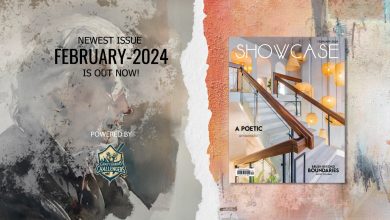Dhali Al Mamoon
Dhali Al Mamoon is both an artist and a professor, born in 1956 in Chandpur district. In 1972, he obtained a master’s degree in fine arts from Chittagong University. In 1993, he completed a two-year DAAD course in fine arts with a German government scholarship.
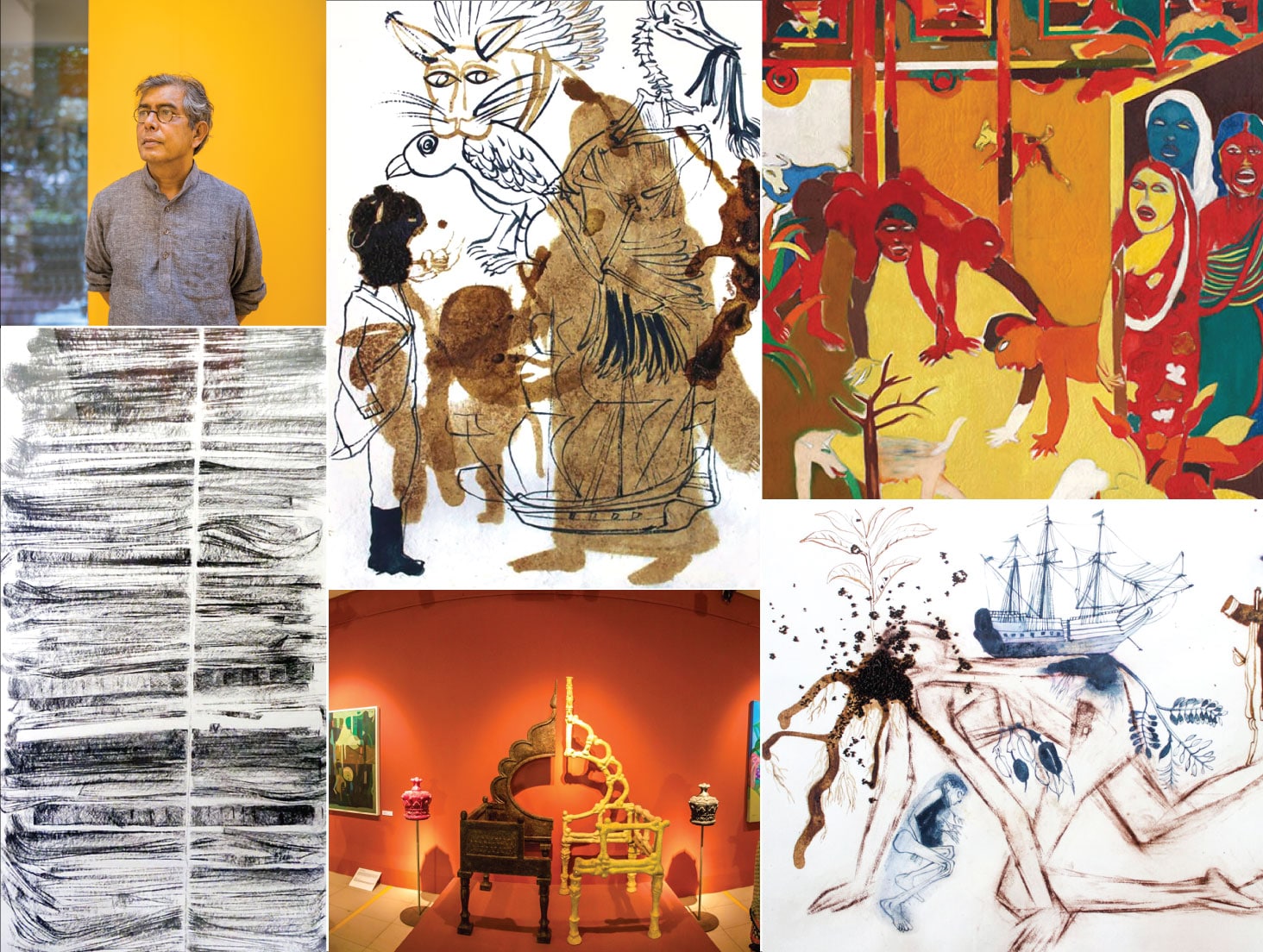
Since the tail end of the 80s, Dhali Al Mamoon has been an art educator.
In the four decades that he spent creating art, a lot of his focus has been on decolonising the language of art in Bangladesh.
His work steps away from institutional practice to assume a unique identity.
A lot of his inspiration came from his childhood, Dhali Al Mamoon says.
When he was a child growing up in Chandpur, one of the things that influenced him was the Chhayabani cinema hall and the daily advertisement that it ran. Aside from that, the plural society back then also left an impression on his earlier works.
As an artist, Dhali Al Mamoon has had a hard time relating to the art scene in Bangladesh which prioritises modern art. In fact, it has always been difficult for him to separate modernism from colonialism.
Bangladesh’s art scene, in general, went through a resetting process after the liberation war in 1971, and Dhali Al Mamoon along with his peers wanted to create a new perspective.
Back then, works such as rickshaw paintings or cinema posters were not regarded as art at all. Dhali Al Mamoon and his contemporary artists worked to change that, as these examples were more in tune with the country’s people and the situation back then. This type of art language inspired him greatly.
Dhali Al Mamoon’s works have been showcased in numerous group and solo exhibitions both at home and abroad. He has also received several national and international awards and honours. The significant solo exhibitions of Mamoon’s works include Time, Coincidence and History (Bengal Gallery of Fine Arts, Dhaka, 2016) and Aponayon/ Elimination (Bengal Art Lounge, Dhaka, 2014). In 2013, his works were presented in the Bangladesh Pavilion at La Biennale di Venezia. Mamoon was awarded the Grand Prize at the 12th Asian Art Biennale, Bangladesh (2006).
Lately, he’s been working on painting and animation based on the Battle of Plassey and Buxar, the two events that changed the history of Bengal forever.
Text by K N Deya
Farjana Rahman Bobby
Farjana Rahman Bobby is an adventurous printmaker, a visual artist, currently working for the Kibria Printmaking Studio as a volunteer, who also teaches art to children at the Russian Art Culture Centre. She has broken the traditional rules of printmaking to create her signature in the community.
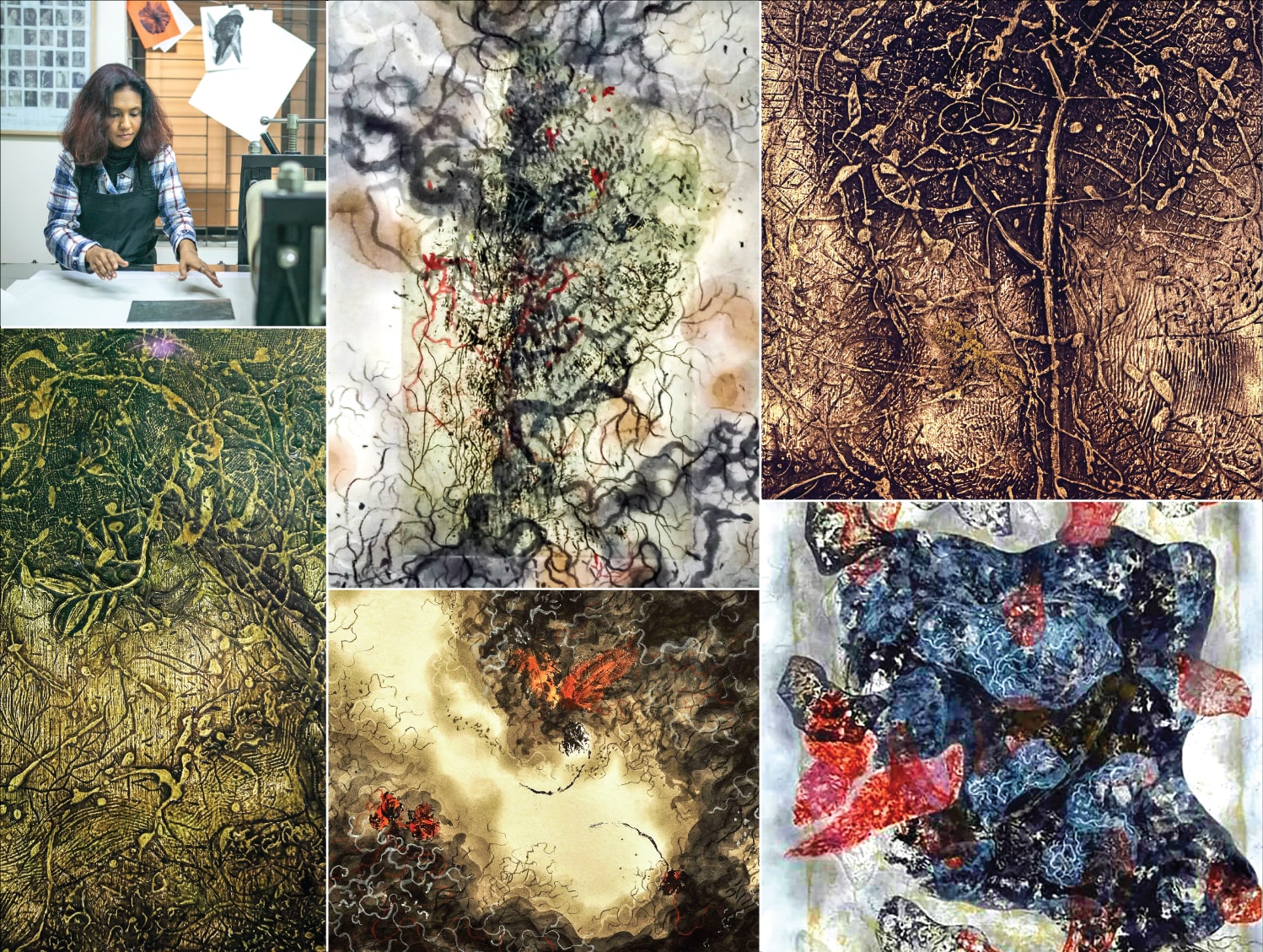
Her perpetual involvement in the arts as performance, music, and storytelling naturally got her into drawing and sketching. Even though Bobby did not intend to be an artist professionally, with her mother’s motivations and her own desire not to have the conventional life, she choose the art life, by studying art at Charukola, and never looked back. She graduated from the University of Development Alternative, in Fine Arts.
The first class Bobby attended on printmaking was enough to get her hooked on this medium as it seemed very adventurous and exciting and offered challenges that she looked forward to solving. She was also inspired by Rembrandt’s and Goya’s works, especially the etching works. The process of printmaking is difficult, it requires a lot of careful planning, from the plate preparation, choosing the material for the plate, to the acid wash timing, to the ink used for the print, the paper preparation and finally making the print itself. It requires the artist to have a very clear vision in the form of a final layout, and they also need to have the plate fully ready before they can make the first print.
Bobby’s method of printmaking is slightly different wherein she starts her drawings straight onto the plate rather than creating a final layout and then slowly develops the work while taking prints.
Bobby is mostly inspired by nature as is evident in her work, as well as finding inspiration from daily life. Primarily her subjects include leaves, trees, earth. Her first solo, held in Shilpangan, titled ‘The Soul of the Soil’, was the compilation of 10 years’ worth of work consisting of 76 pieces of prints in total. Her work includes a series named Foliage, Leaf of a Forest, Foliage on the Rock, and Rock in the Wilderness. She is currently working on a series named Bhumi, meaning earth. The death of her beloved father spurred the emotions for this particular series as we are made from the earth and to it we all return.
Text by Sophy Ayman
Hamiduzzaman Khan
Immersed in a voyage into the arts at an early age, veteran sculptor Hamiduzzaman Khan has left his mark internationally, having displayed works in Bangladesh, South Korea, India and US. The acclaimed artist, primarily recognised for his sculptural contributions, was awarded the Ekushey Padak, the second-highest civilian award in Bangladesh.
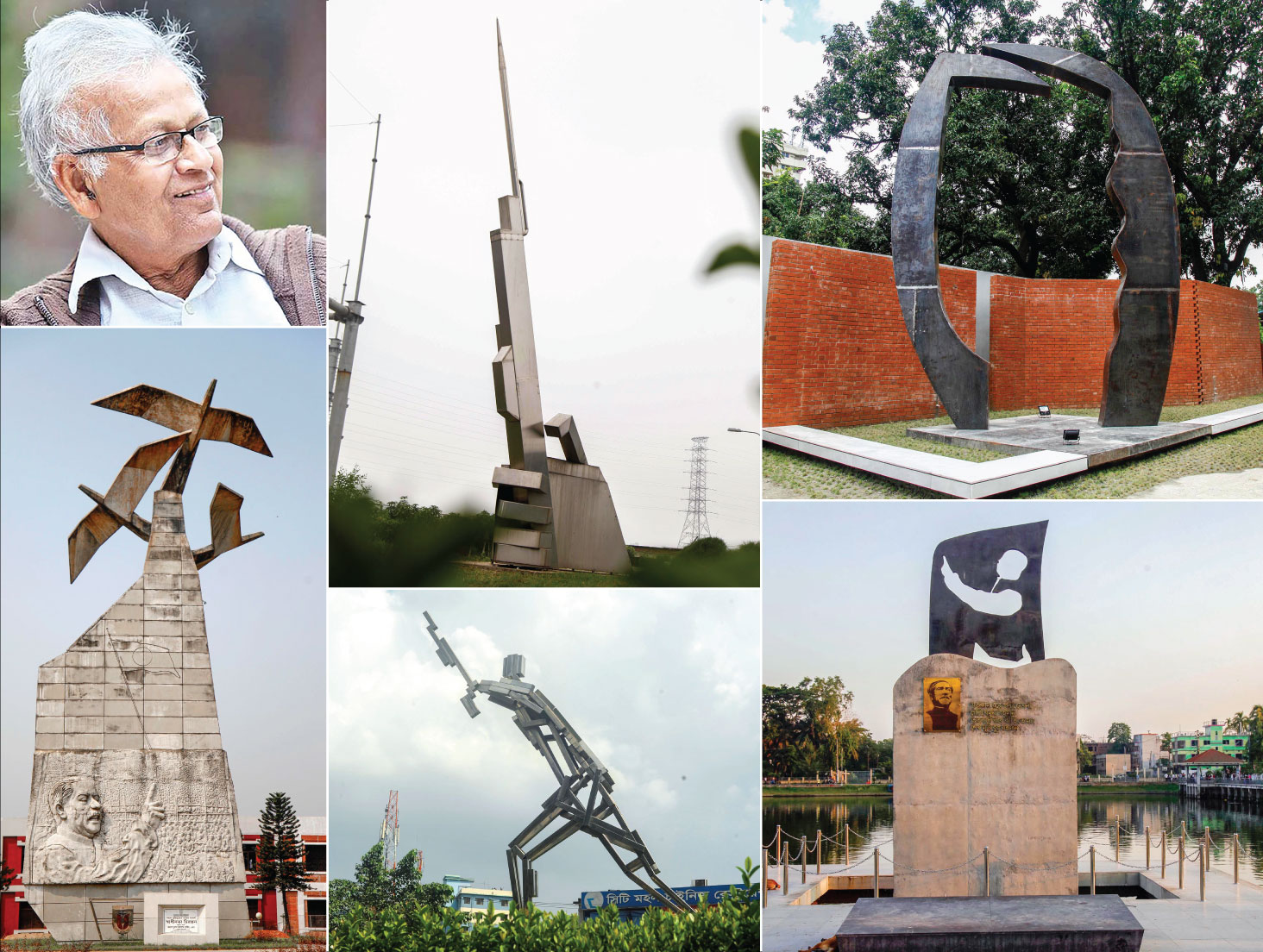
Despite having already been enrolled in a medical college as per his father’s wishes, Hamiduzzaman’s determination to pursue arts ushered him onto the doorstep of the founding father of Bangladeshi modern arts, Zainul Abedin. His meeting paved the way for his enrollment at the Charukola Institute, formally known as the Faculty of Fine Arts, University of Dhaka. There he was educated under the guidance of many fabled artists.
Hamiduzzaman Khan, not wasting a moment’s time, submerged himself into his work. “Art was something intoxicating for me, when I began creating, the days passed without my notice and everything else seemed like a blur.”
During his final year at Charukola in 1967, Hamiduzzaman met with an accident that nearly claimed his life. Nevertheless, encouraged by Zainul Abedin, he was able to attend his final examinations. Needing further reconstructive surgery, Hamiduzzaman Khan, was off to Edinburgh, UK, where he garnered inspiration from numerous museums, cultures, nature and public sculpture installations. Particularly fascinated by the metaphysical modernity in forms of sculpture, he returned to Bangladesh and began his specialisation in sculpture.
Primarily having delved into sculpture a year after the Liberation War, it remains in thematic relation scattered throughout his impressive portfolio spanning decades.
Contemporarily, one of the various projects he has undertaken is at the ‘Hamiduzzaman Sculpture Park’, lush with breathtaking landscaped greenery situated on the 100ft road, where he is creating murals on a monumental wall spanning 400ft in length.
Speaking of the processes that accompany such massive undertakings, he says, “Prior to commencing any large projects, I visit the area alongside an engineer and an architect to map the area and the feasibility of my visions. Afterwards, I make around a few hundred sketches a day until I am satisfied with one that aligns with my view and the client’s requirements. After selection, I create a model and a presentation.”
While many are witnesses to the magnificence of sculpture, at a glance it does not disclose the copious amount of effort, time and careful calculations as well as the thought processes that are vital for every piece in creation.
Text by Zariat Mushfique Khan
Hasan Saifuddin Chandan
Hasan Saifuddin Chandan is an award-winning photographer, the pioneer of architectural photography in Bangladesh, who has been in the field of photography professionally for 42 years. He is currently working on multiple documentary projects and architectural photography while teaching photography at the Bangladesh University of Engineering and Technology (BUET)
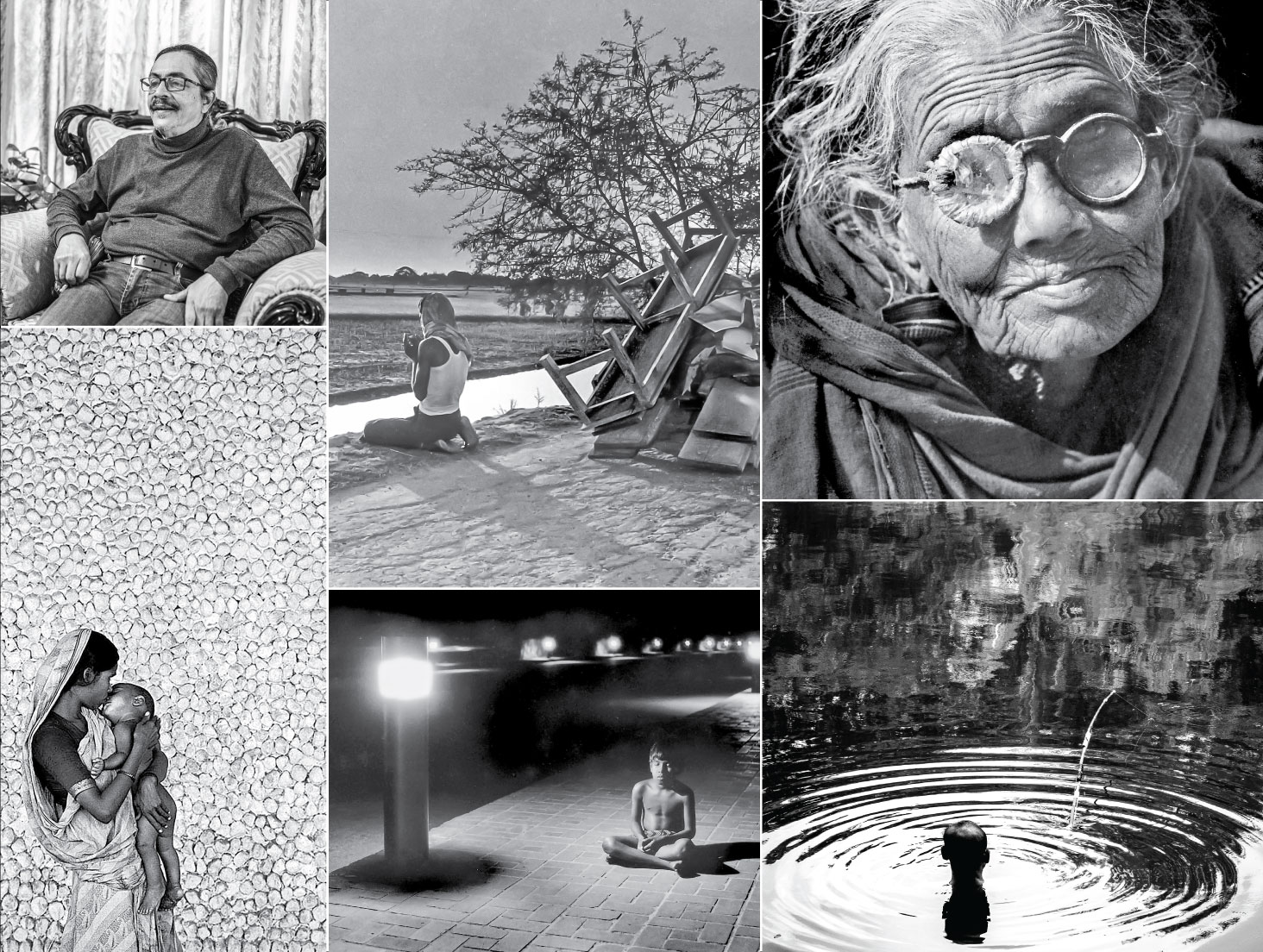
Chandan’s journey started with a Kodak Clack loaned to him from his father’s friend, at the tender age of 7. He upgraded to a professional camera, a twin-lens Minolta Autocord, as well as a bulb flashgun and received training from his father on some techniques for achieving correct exposure, at the age of 10. In 1981, Chandan found a child’s portrait exhibited in the first national exhibition arranged by The Bangladesh Photographic Society (BPS), with the name of the printer whose studio had been developing the negatives for him. Chandan contacted the then principal of BEGAT Photography, Mr Manzur Alam Beg, who, upon hearing Chandan’s story and his interest in photography, got him admitted to the Bengal Institute of Photography. He became a member of BPS in ’82 and won the first prize in the monthly photo contest which was highly motivational for him. In 1986, he became the Photographer of The Year from BPS, winning the first, second places and the Honorable Mention. Throughout his career, he has won many awards including the Gold Medal from Fédération Internationale de l’Art Photographique (FIAP), in Spain, the Grand Prize in “Street and People”, Asian Cultural Center For UNESCO, Japan, 3rd prize in NIKON Photo Contest, FIAP Silver Medal in the International Photo Competition Celebrating 150th Anniversary of Photography in France.
In 1989, Chandan started working 5 years on his Kamalapur Railway Station, inspired by legendary photographer Raghu Rai’s Taj Mahal. In 1994 his 1st solo exhibition with the pictures of Kamalapur Station was held in Biel, Switzerland. 10 pictures of Kamalapur Station was also exhibited in Pablo Piccaso & Victo Hugo Museum in 1996, Celebrating the 150th Anniversary of Photography in France. There he got FIAP Silver medal among the 9 other photographers from 9 countries. Map Photo Agency – the first cooperative photo agency in Bangladesh was founded in 1993, along with 3 photographer friends. Chandan was familiar with architectural drawings, perspective drawings because his sister was an architect and he used to help her with her drawings. This perspective has helped him immensely in Chandan’s particular line of work as all his photographs always had an inherent graphical feel.
Over the years, Chandan has been working on multiple series such as Gabtoli Bridge series from 1979 till date, Shaheed Buddhijibi Sriti Shoudhu, Suhrawardy Udyan, Dhanmondi Lake from 1998 till date, and Charukola, inside the Fine Arts department. The reason for picking these spots and continuing projects for years is because it seemed to him that the scenery would change depending on the time of day, day of the month, the month of the year, a season of the year. “The idea that something that did not seem to change was still changing was fascinating to see through the lens of my camera”, he expresses.
A photo enthusiast who has lived through the technological advancements in camera equipment and method of photography, Chandan believes, “Instead of trying to think that you need better equipment to get better shots, you must learn how to maximize the capabilities of the available equipment. Gears only do not determine the outcome, but it is determined by the photographer’s knowledge experience and philosophy as a whole, who is using it.”
Due to his years of experience and his knowledge of topics ranging from psychology to economics to architecture, he likens the lens to a paintbrush, and depending on the thickness of the brush, the picture will change.
Hasan Chandan has spent years perfecting his craft, using his camera lens to view that world and use his photographs to tell a story in a language that transcends time.
Text by Sophy Ayman
Mahbubur Rahman
The Co-Founder Britto Art Trust, the first non-profit artists’ collective in Bangladesh and Charukola alumni, Mahbubur Rahman describes his fascination towards art as dawning in the eventful nooks of Puran Dhaka, nurtured by the encouragement of his father.
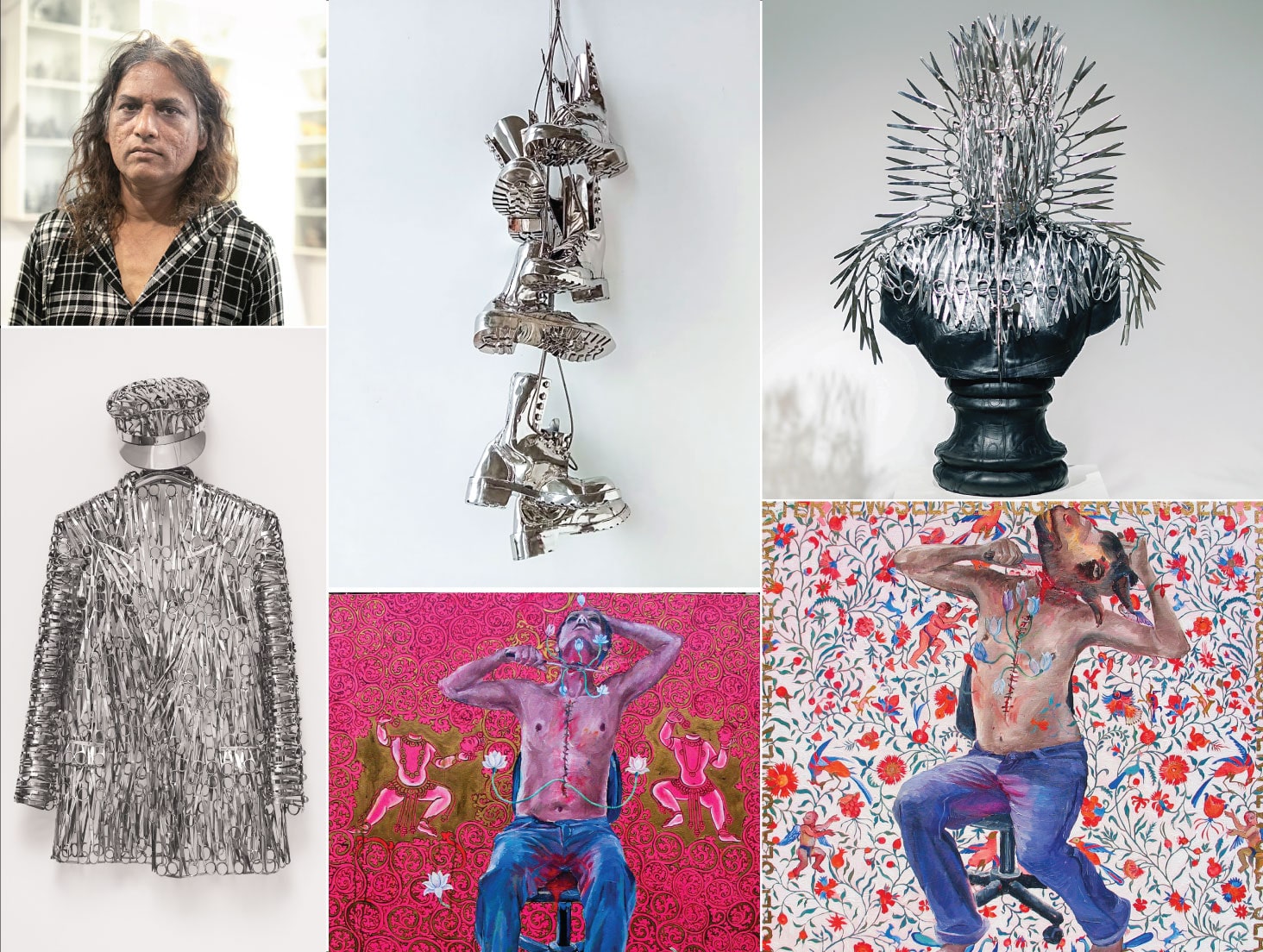
A free spirit in his adolescence, art gave him the structure he needed to sculpt his dreams. The multimedia artist’s practise includes drawing, sculpture, installation, performance and video. He has incorporated themes of society, loss, grief, history, among others, in his pieces.
Not confining himself to one medium, his explorative nature allows him immense diversity in his work.
“When I begin developing a project, I consider the execution. I ask myself, ‘How do I communicate my vision to the viewers?’ Thinking of another perspective allows me to add nuances and layers to my work, enriching the process and creating a relationship with onlookers. I begin with the space, location, position, materials, then I move on to the technicalities of reality. I have to think about whether it is portable, sharp and even the longevity of it.”
When asked about a piece that is close to his heart, he shared a rare insight into the motivation behind two specific pieces, Rathpa and Rathja, created in 1991 inspired by his father’s battle with cancer.
“I couldn’t bear to look at my father dressed in a hospital gown, being taken away on a stretcher. It felt like I was watching helplessly as angels carried him away. The operation was successful, but my father never regained consciousness. The fact that he went in, and never came out was killing me, I needed to relieve myself.”
In his third year of university, he created this sculpture of four figures, surrounding a man lying down on four black boxes with a ribbon in the shape of a cross, which we now know is the physical manifestation of the grief of losing his father and a visual manifestation of what his last moments may have been like.
The pioneer of the mixed-media approach in the country is currently working on several projects, including an artistic collaborative effort. On the topic of the experience of having a partner in the same field, working with similar mediums, together, Mahbubur states, “If the world is in your room then, you don’t need to go out.”
Text by Zariat Mushfique Khan
Nasima Haque Mitu
Of all the fields of art, sculpture is the one most in tune with the elements, as it moulds and flows to take on the form of the mind’s eye. Sculptor, Nasima Haque Mitu, most encapsulates this feeling through the spiritual relationship she forms with the physical media she uses as instruments to create to her heart’s content. Currently the Assistant Professor & Chairman of the Department of Sculpture at DU,
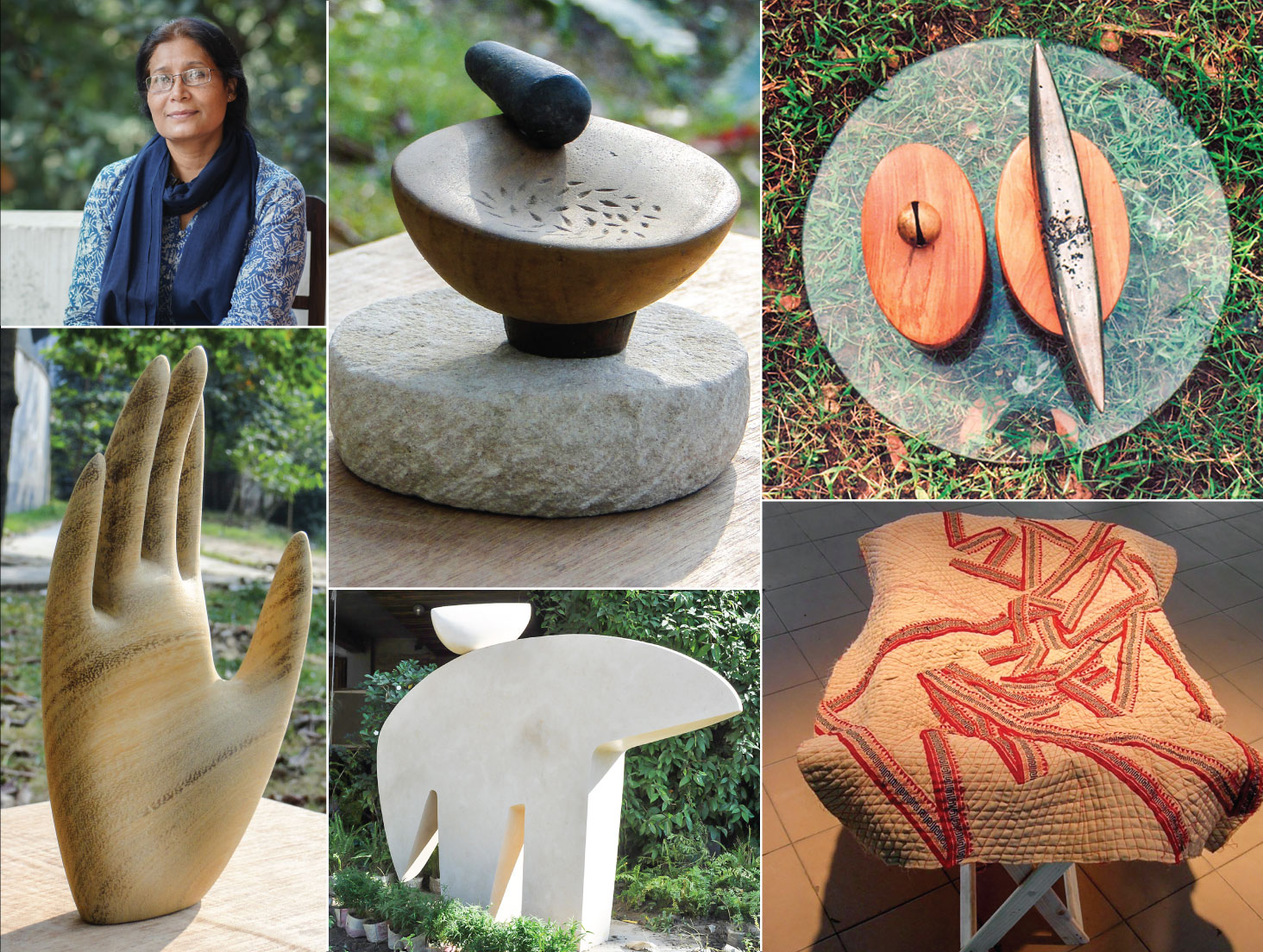
Mitu has in one way or the other always been engaged in eclectic disciplines of art, whether visual arts, music, or others.
Upon an enquiry as to why she chose Sculpture as her field of interest, Nasima Haque Mitu says, “When we are asked to decide our focus at Charukola, I decided I wanted to paint. Then, one day, I visited the sculpture department of the university. The entirety of the vast ground floor was draped with charcoal sketches. This scene captivated me, in that moment I knew that this is where I belong.”
Elaborating upon her preferred mediums, Mitu says, “I am most comfortable with maati, which is either transferred to cement, metal or it’s cooked. I’ve found that I had a preference for a hands-on approach directly with the material itself. I’ve practised wood carving for ages, I still do. I am fascinated by the unique disposition and character that every piece of wood has. There’s always a sense of enigma about whether this material understands me, and I, it.”
Enjoying variety in her tools, the sculptress has used metal, cotton, thread, and even perishable elements such as wheat, to create her elaborate pieces. However, she prizes accessibility as an important factor, favouring materials that are a part of her day to day reality.
Speaking of her choice to teach she states, “I chose to teach because I was aware that, through teaching, I will always be affiliated with sculpture and remain a part of the creative process of a new generation of artists.” Noting the current shift towards digital art forms and media, Nasima Haque Mitu believes this to be positive. She enjoys being privy to the artistic preferences and changing themes of her students. However, being aware of the overwhelming influx of cultural shifts leaning towards westernisation, Mitu advises aspiring artists to remain true to their identity and retain their individuality.
Text by Zariat Mushfique Khan
Rafiqun Nabi
Rafiqun Nabi also known as Ranabi, is a legendary artist and the creator of the insanely popular cartoon character Tokai, who became an artist to fulfil his father’s unrequited desire to be an artist himself. He started his art journey learning to draw on a slate sitting on his father’s lap and hopes to keep going ahead in his artistic pathway as long as he is able. He received his undergraduate and master’s degree from East Pakistan College of Arts and Crafts (now Faculty of Fine Arts, University of Dhaka). He studied under the supervision of artists like Zainul Abedin and Quamrul Hassan.
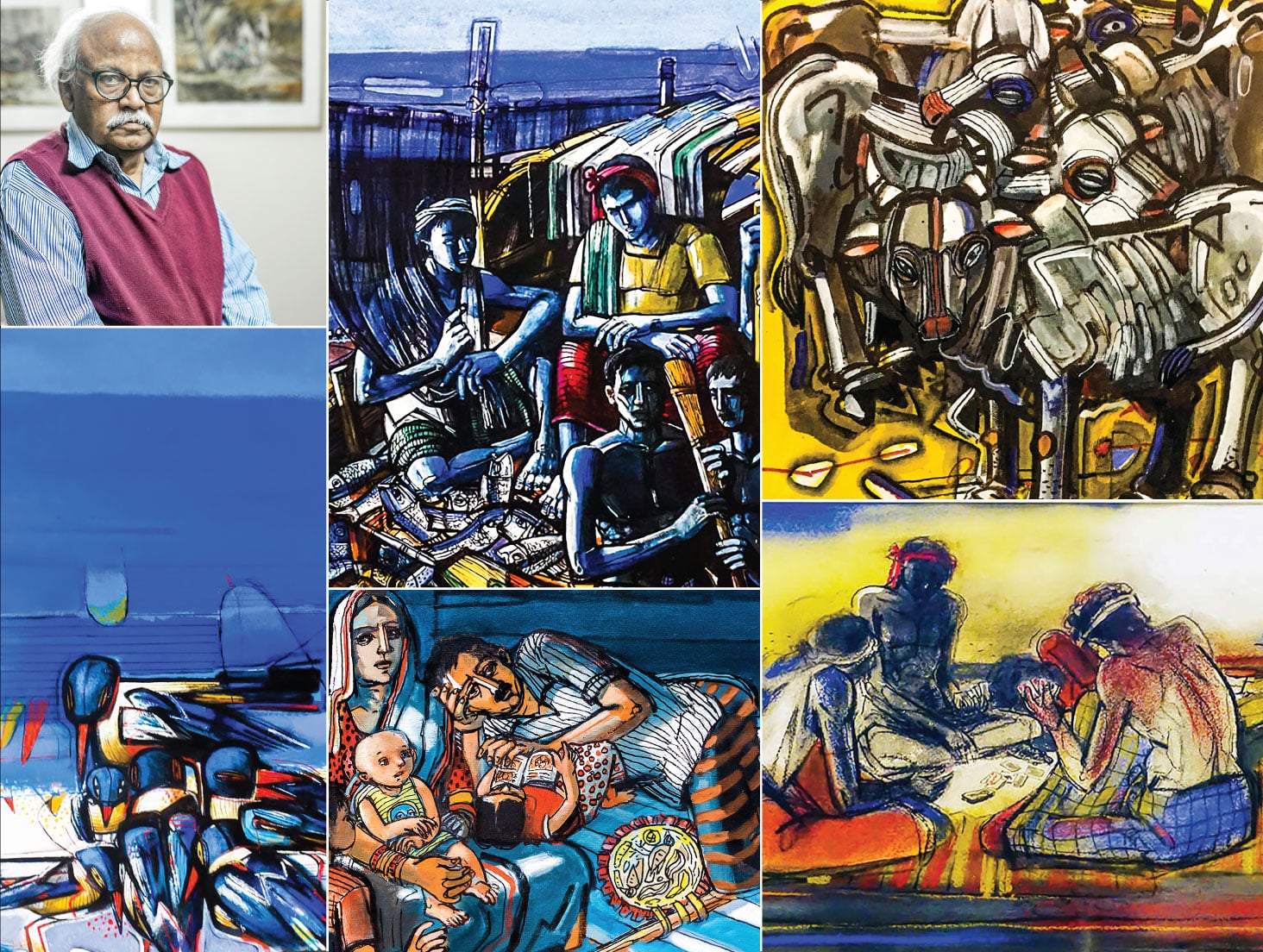
Ranabi served as a faculty member of the Faculty of Fine Arts, the University of Dhaka during 1964–2010. Ranabi began his career as a cartoonist in 1963. His first contribution appeared in Weekly Purbodesh. His cartoons for Abdul Gani Hazari’s column Kaal Penchar Dairy were illustrated in Shochitro Shandhani starting in the mid-1960s. He worked for the Weekly Express in the late 1960s. He studied printmaking, primarily doing research on woodcut printmaking at Athens School of Fine Arts under the Greek Government’s postgraduate scholarship from 1973 to 1976. Ranabi returned from Greece in 1976. He began to contribute cartoons to the Weekly Bichitra and Dainik Bangla. He created the character Tokai, which first appeared in the anniversary issue of Bichitra in May 1977.
Tokai was created as a medium to convey very heavy but accurate political and social commentary at a time of great unrest.
The artist’s time in Greece was very illuminating for him as he found his Greek mentor doing incredible woodcut prints which inspired him to do them himself. Ranabi is not bound by any medium and happily shifts from painting to drawing to cartoons to woodcut prints, whichever strikes his fancy. And when art bores him, he switches to writing which he says is a pathway to prepare for painting again.
Rafiqun Nabi’s awards include the Promoters Prize, Inter Graphic-80, Berlin (1980), Bangladesh Shilpakala Academy Award (1989), the Ekushey Padak (1993), Agrani Bank Award for Children’s Book Design (1995), and S M Sultan Padak (2002). He received the National Book Centre prize for Children’s Book Cover Design several times between 1968 and 90.
Text by Sophy Ayman
Shishir Bhattacharjee
To the citizens who regularly parse through a daily newspaper, the name Shishir Bhattacharjee is well worn and dearly beloved. His cartoons and caricatures liven up the newsprint pages like no other. In fact, he’s the one who led cartoons and caricatures to become a mighty tool for fighting injustice. In a rendezvous with Showcase magazine, the maestro opened up about his likes, dislikes, and inspirations in the realm of art.
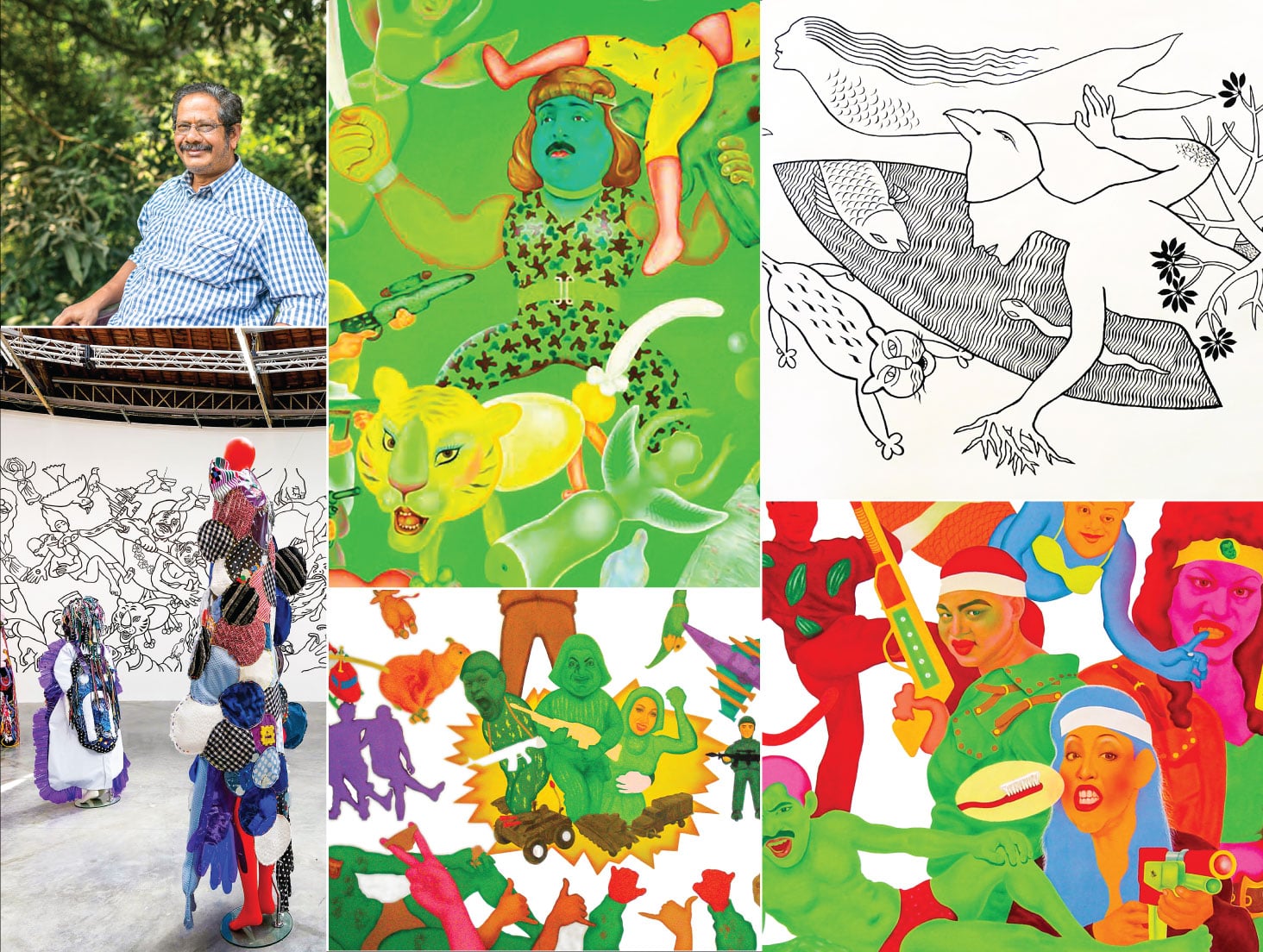
When asked about his favoured artistic tool, he promptly mentioned black liners, the ones commonly known as gel pens. He also favours thin watercolour brushes with black ink or black acrylic colour- all of them on a white surface. The surface colour might change, but he always prefers working with black. In the past, he used to incorporate many vibrant colours. But lately, he seems more inclined to use black and white.
The reason for this, he confirmed, is to convey his messages simply. He has found that the use of vibrant colours gives a new dimension to the message he is trying to give out. As he wants each artwork to bear a straightforward message, he uses black and white. He still sometimes uses colour on the ground of the artwork to convey different feelings such as warmth, suppression, or a sense of gloom but the lines remain black.
Talking about artists that he looks up to, Shishir Bhattacharjee first mentioned Zainul Abedin and Quamrul Hassan. “Without them, we would be nothing. Even now, Quamrul Hasan’s works with their lines and images are fascinating,” he stated. Among foreigners, he mentioned K. G. Subramanyan and Jogen Chowdhury as particular favourites. “I was heavily inspired by the expressionist artists who fought against Nazi suppression with their work. Both their artwork and ideologies were important to my growth,” he said, adding that Otto Dix and George Grosz were the most influential among them. Other than that, early Renaissance artist Bosch’s works also inspired the cartoonist.
“When I was making cartoons in protest of Ershad’s regime, satirical and mocking works by these artists helped a lot as references,” he added.
Lately, the artist has found that there’s a lot left to do in terms of visual pictorial language. He keeps finding new things to learn every day from the elements in nature, which are virtually endless in their variation. “All these wonderful variations make me think: there is a creator who is doing all these things,” he said with wonder. “But what kind of artist is the creator, whose design sense and colour sense all are so good, we can’t even get close to his skills! If only I could open myself in the midst of nature, the possibilities would be endless.”
Text by K N Deya
Tarun Ghosh
“Life without art is death” as Tarun Ghosh succinctly narrates, is very true when it comes to his life. Fascinated with art from an early age, Tarun developed an eclectic personality as an artist. His talents in drawing blossomed at an early age, which made him connect to the artistic side during his schooling years when he took charge of wall magazines at his school in Rajbari.
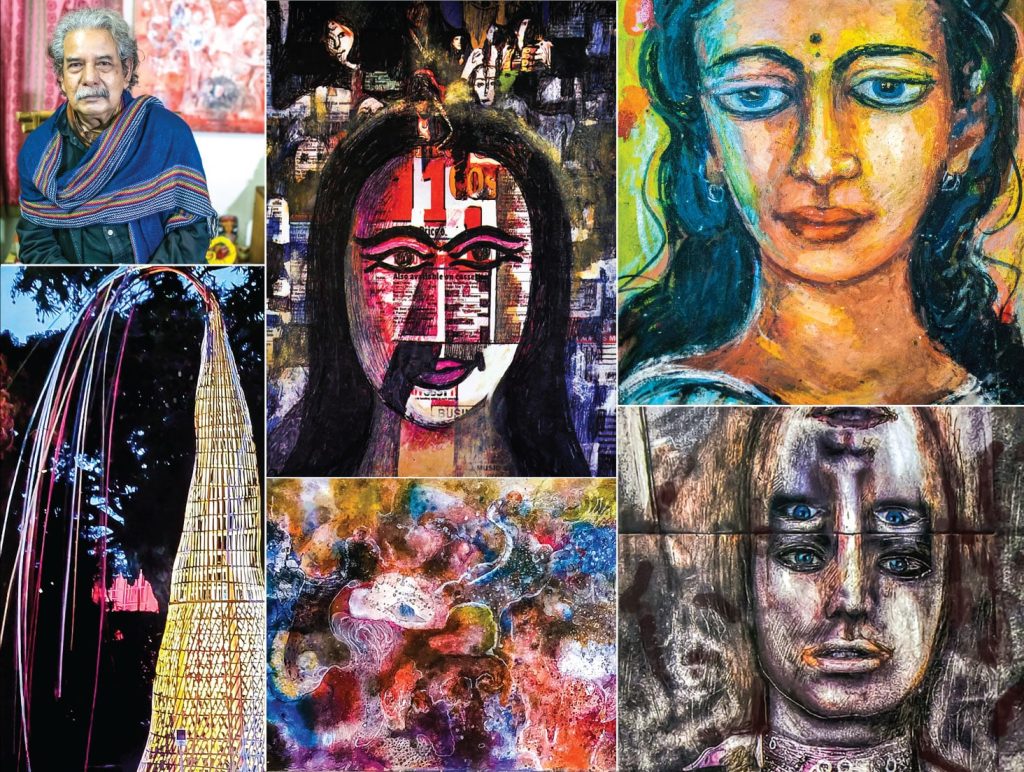
His exposure to the ethnic arts and handicrafts of the Pal community, and the traditional ‘alponas’ for puja made by his mother influenced his artistic repertoire.
Tarun specifically mentions listening to the tragic stories of Behula growing up, and realising the importance of such folklore in the culture for representing the hardships experienced by women in the societal context of the subcontinents.
Tarun’s earliest academic goal in life was to study at ‘Charukola’ – The Institute of Fine Arts, University of Dhaka, which he could not attend at the time as the Liberation War broke out and he went to India to receive combat training. Due to being too young, he was held back in India and only returned to Bangladesh after the war ended. The tragedies of the war left a scar on his psyche. Tarun mentions his reason for drawing so many portraits as seeing the destroyed photos and paintings in the ruins of his house after the war and wanting to capture those faces he would never see again.
After the war, Tarun got admitted into Charukola, where he honed his art fundamentals and learned new techniques to eventually transition to oil paintings. Tarun favoured portraits at the time, but during his Master’s, he developed a keen interest in mythology and folklore, helping him transition from portraits to drawings and abstractionism. He made over 100 drawings to master the fine details.
Tarun’s allure of folklore inspired his art series ‘Behula’ after the completion of his Master’s degree, which he touts as his favourite work among his own. He also mentions ‘Roots’ by Frida Kahlo as one of his favourite artworks. Tarun also developed artistic techniques relating to modern art, surrealism, and impressionism. He expressed his desire to work with ‘space’ in the future.
Text by Marzana Tasnim
Yasmin Jahan Nupur
Drawing inspiration from daily life, Yasmin Jahan Nupur is a visual artist who mainly works with performance art, installations, and videos.
Her art is research-intensive and she dedicates a considerable amount of time to each of her projects.
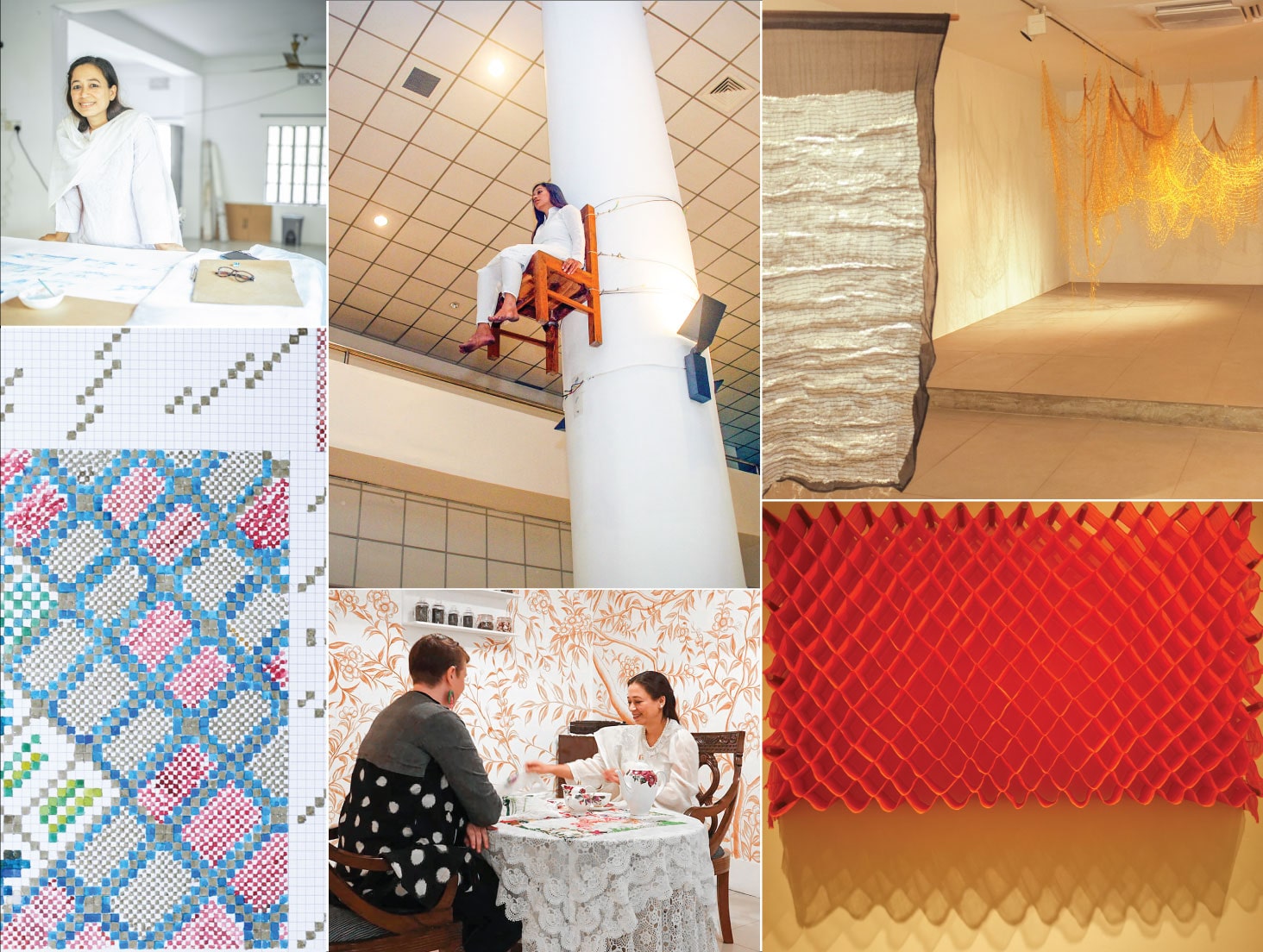
From conceptualisation to the end product, it takes Nupur around four to five years to complete each project and her works show why. Each of them is not only well thought through but brilliantly executed and radiates the passion, patience, and determination she pours into her art.
One of her most notable works is ‘Sat on the Chair’ which was exhibited at Dhaka Art Summit in 2014 where Nupur herself sat on a chair tied to a pillar and placed about 17-foot above the ground. She undertook the venture despite being terrified of height. She said the idea of the performance had been on her mind since 2011 when she was attending a residency programme in Mauritius and through the work, she tried to communicate with the audience without using any words.
“When I was up there in the chair, I tried to imagine what the audiences were feeling and they were doing the same. We communicated in silence and sometimes through eye contact,” she added.
Nupur’s artistic journey started even before she learned the alphabet. “My father was great at technical engineering and architectural drawing so, every time he sat to practice, I tagged along,” she said. When attending the SSC examination, Nupur received her first formal training in art and when the time came to pursue higher education, Nupur got admitted into the University of Chittagong where she majored in Painting and Drawing. During her time there, she attended a workshop on performance art which had a profound impact on her. “At the workshop, I was fascinated by how a body can become a performance and an art itself and learned the ways to represent that in any given space,” she added. Nupur loves to dive deeper into her projects to understand them better and right now, she is working on a performance about keeping secrets. “I have not told anyone about it yet, doing the drawings and painting my thoughts right now and I am excited to see what I come up with,” she said.
Text by Marzana Tasmin

